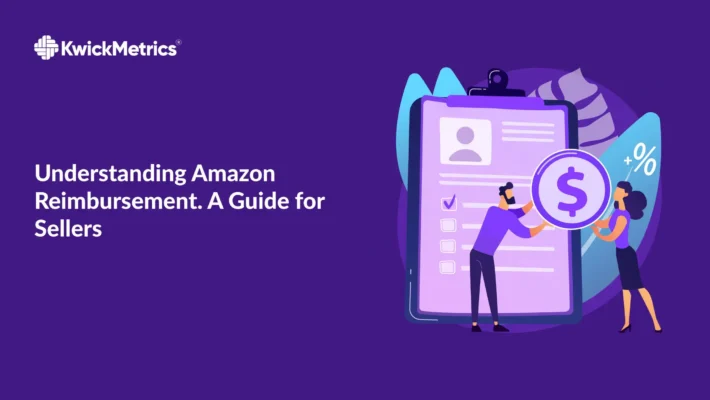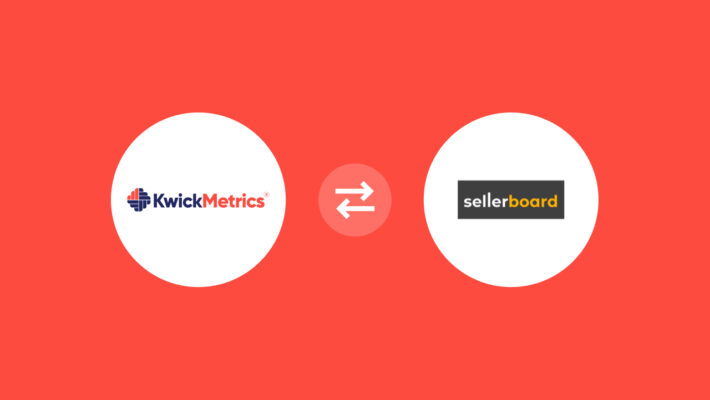Amazon Profit Calculator: Enhancing FBA Margins in 2024

Table of Contents
- Understanding Profit Margins on Amazon FBA
- The Different Types of Margins You’ll Encounter on Amazon
- How Much Does Amazon Take from Sellers?
- Interested to view how a sample Profit and Loss Report looks and what all it covers?
- Strategies to Boost Your Amazon Profit Margins
- Future Prospects for Selling on Amazon
- Key Insights from Successful Sellers
- FAQs in Relation to Amazon Profit Calculator
- Conclusion
- Try Our KwickMetrics - One Tool with Multiple Solutions!
Navigating the world of Amazon Profit Calculator, Amazon Profit Margin, and Amazon FBA profit Calculator can be a complex journey. When it comes to maximizing your earnings on this e-commerce giant, the biggest challenge is understanding how these calculators and margin’s function. Many sellers are completely unaware of how they work. However, mastering this aspect sets apart an average seller from a successful entrepreneur. Without knowing how to effectively utilize these tools or comprehend their impact on your profits, reaching that next level may seem impossible.
Folks, understanding Amazon Profit Calculator, Amazon Profit Margin, & Amazon FBA profit Calculator, isn’t easy!
Understanding Profit Margins on Amazon FBA
Diving into the world of Amazon FBA? Let’s dissect its profit margins.
Most Amazon sellers have profit margins between 15% and 20%. Impressive, right?
If you’re above that range, you’re killing it. Consider yourself excellent in the game.
Calculating Your Amazon Profit Margin
But how do we get these numbers?
We use formulas like
Gross Profit Margin (Net Sales – COGS / Net Sales x 100) and Net Profit Margin (Net Sales – COGS – Operating expenses – Taxes – Interest – Other expenses / Net sales x 100).
The Different Types of Margins You’ll Encounter on Amazon
Let’s talk about margins.
As an Amazon seller, you’ll come across two types: operating and gross margins.
Gross Margin Explained
This is the first type of margin to understand when selling goods on Amazon.
After deducting the cost of goods sold from total sales, the remainder is your gross margin – similar to finding extra money in your pocket after shopping.
It’s like finding money in your pocket after paying for your shopping spree.
Operating Margin Explored
The second key player in our journey through Amazon profit margins? Operating margin.
This metric takes into account not just your variable costs but also fixed expenses like rent or salaries.
It’s like balancing your budget while juggling flaming torches.
So why are these figures important?
These figures offer a comprehensive view of the financial performance and future potential of your business.
A good profit margin can mean more money to invest back into improving product quality, expanding inventory, or exploring new markets – all vital strategies for staying profitable amidst ever-changing market dynamics.
Key Takeaway:
Gross margin and operating margin are two important metrics that measure your profitability as an Amazon seller. Gross margin is the difference between your total sales and your cost of goods sold while operating margin is the difference between your gross margin and your fixed expenses. A good profit margin can help you grow your business and stay ahead of the competition.
How Much Does Amazon Take from Sellers?
When you start peddling your wares on Amazon FBA, there are some charges that could reduce your earnings.
FBA Fees: The Sneaky Cost
Amazon FBA fees based on the size and weight of your products, not their prices. It’s like paying rent for your stuff in Amazon’s warehouses. Amazon takes care of the delivery and returns, enabling you to devote your energy to expanding your enterprise.
Referral Fees: The Silent Tax
On top of FBA costs, there are referral fees that Amazon takes from your sales. These fees can range from 6% to 45%, depending on what category your products fall into. It’s like a secret tax that sneaks up on you.
Closing Fee: The Unexpected Surprise
If you’re selling media items like books or DVDs, Amazon throws in an extra closing fee.
Keeping track of expenses is essential to ensure profitability despite the variable costs. Remember, it’s not just about how much money you make, but how much you get to keep after Amazon takes its cut.
You can use tool like KwickMetrics to identify all your hidden costs including above mentioned fees to calculate your Amazon profit margin.
Interested to view how a sample Profit and Loss Report looks and what all it covers?
Strategies to Boost Your Amazon Profit Margins
Want to maximize your Amazon profits? Here’s how:
Optimize Product Prices for Maximum Profits
Pricing is key. Set your product prices strategically to increase your profit margins and net sales.
Reduce Costs by Improving Sourcing Operations
Don’t let shipping fees and variable costs eat into your profits. Find ways to lower FBA costs without compromising quality.
Enhance Product Listings for More Sales
A compelling product listing drives traffic and boosts conversions, improving both gross margin and net profit.
Refine Ad Campaigns for Higher ROI
Optimized ad campaigns drive potential customers to your products, resulting in higher returns on investment.
Expand Into Foreign Markets for Greater Reach
Tap into new markets to increase sales volume, improve profitability, and stay profitable despite low profit margins.
Be constantly searching for strategies to maximize your Amazon business’s success. It’s a constant game of adaptation in the ever-changing e-commerce landscape.
Key Takeaway:
To maximize Amazon profits, strategically price products, optimize sourcing operations, improve product listings, refine ad campaigns, and consider expansion into foreign markets. Adaptation is crucial in the dynamic e-commerce environment.
Future Prospects for Selling on Amazon
You need a strategic approach. Sellers who optimize product prices based on market trends tend to see better net sales. In addition, reducing FBA costs by streamlining operations also contributes significantly towards maintaining good profit margins.
Moving forward, it will be essential for every seller to stay updated with changes in Amazon fees and variable costs associated with shipping goods sold via Amazon’s warehouses.
By doing so, they’ll be able to keep direct costs low while maximizing profits from each sale made through the platform.
Key Insights from Successful Sellers
Navigating Variable Costs for Greater Profitability
Successful sellers have cracked the code. They know that managing direct costs like shipping fees and storage can make or break their profit margins.
Multichannel Selling: A Pathway to Increased Profits?
Smart sellers spread their wings and sell on multiple platforms to maximize profits and minimize risk.
Focusing On Customer Service Improvement
Successful sellers also prioritize customer service. Happy customers mean repeat purchases and fatter gross margins.
Just remember, don’t dive into the deep end without doing your market research or pricing your products.
Optimize your product listings
Your product listings are your storefront on Amazon, and they need to be attractive, informative, and persuasive. To optimize your product listings, you need to conduct keyword research, write compelling titles and bullet points, use high-quality images and videos, and leverage features like A+ content and Enhanced Brand Content. By doing so, you can improve your visibility, conversion, and customer satisfaction.
Track your KPIs
Key performance indicators (KPIs) are metrics that help you measure and improve your business performance. Some of the most important KPIs for Amazon sellers are conversion rate, keyword ranking, inventory performance index, Amazon fees, and account health
FAQs in Relation to Amazon Profit Calculator
Q. What should my profit margin be on Amazon FBA?
A. A good profit margin for Amazon FBA sellers is typically between 15% and 20%. Anything above this range is considered excellent, while a margin below 5% may not be sustainable.
Q. How is Amazon FBA profit calculated?
A. Amazon FBA profit can be calculated using the formula: Net Sales – Cost of Goods Sold (COGS) – Operating Expenses. Tools like KwickMetrics’s P & L Calculator can also help estimate potential profits.
Q. What is the average profit margin for FBA sellers?
A. The average profit margin for most Amazon FBA sellers ranges from 15% to 20%, with higher margins indicating exceptional performance in product pricing, sourcing, and marketing strategies.
Q. What should my profit margin be on Amazon FBA?
A. A good profit margin for Amazon FBA sellers is typically between 15% and 20%. Anything above this range is considered excellent, while a margin below 5% may not be sustainable.
Q. What is Amazon’s FBA Margin?
A. Amazon FBA Margin refers to the net income generated by a seller after deducting all associated costs including cost of goods sold (COGS), operating expenses, taxes, and other related fees from gross sales revenue.
Conclusion
Understanding Amazon FBA profit margins is a game-changer. Different types of margins – operating and gross – play pivotal roles in shaping your business health and growth.
Amazon takes its share, but strategic planning can optimize these costs for better profitability.
A handful of strategies are there to increase those all-important profit margins on Amazon. Optimizing product prices, refining sourcing operations, enhancing listings – it’s all part of the mix.
You’ve also learned about the potential benefits of expanding into foreign markets.
With tools like KwickMetrics by your side, navigating through complex calculations like net sales or understanding concepts such as Gross Profit Margin will be an advantage.
Unlocking success with improved profits is just one click away! Ready to take control over your business’s financial performance? Dive deeper into maximizing profitability using our tool today at KwickMetrics. It’ll revolutionize how you approach selling on Amazon.
Happy Selling!



